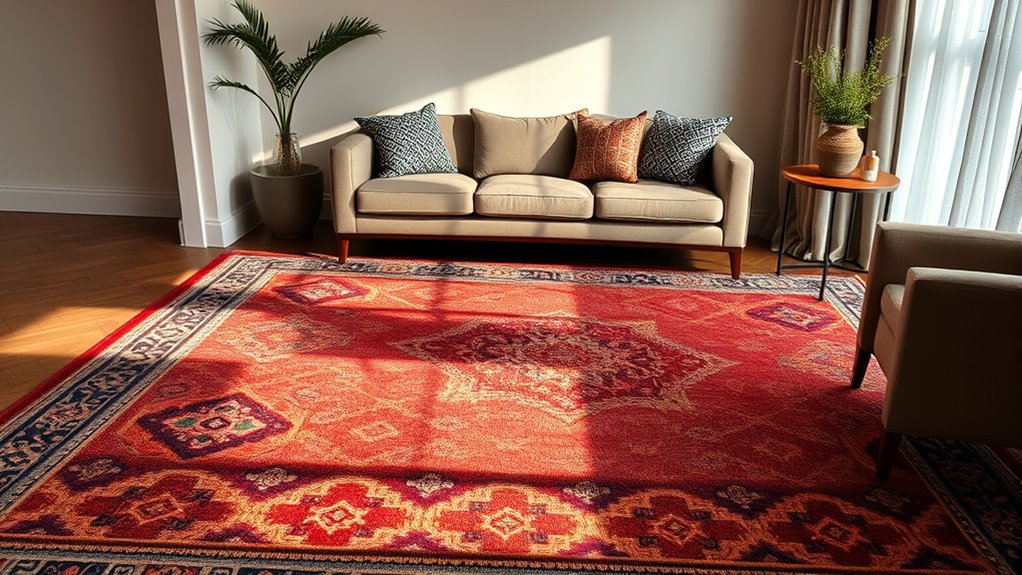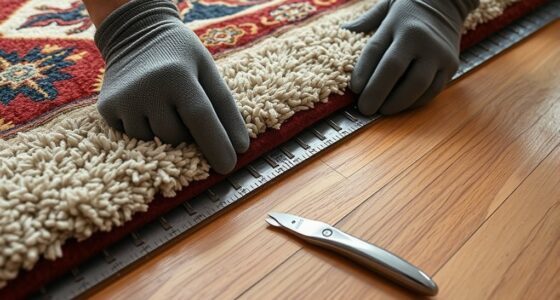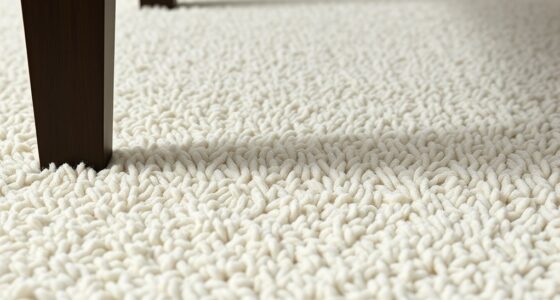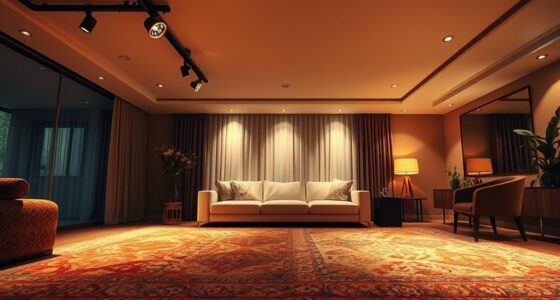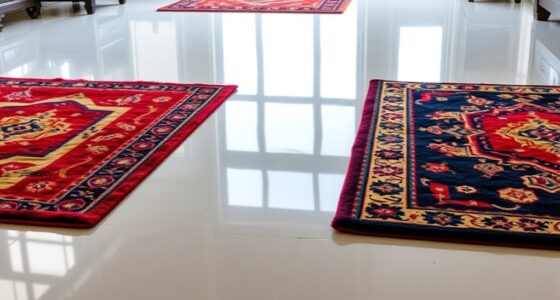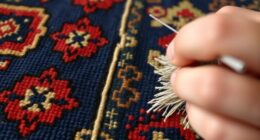Rug patterns in Feng Shui influence how energy, or qi, flows through your space. Symmetrical, calming designs promote stability and harmony, while chaotic or overly busy patterns can create tension and block energy movement. Incorporating meaningful symbols or natural motifs helps enhance positive vibrations, especially when paired with appropriate colors and textures. If you keep exploring, you’ll discover how to select and place patterns that support tranquility and balance in your home.
Key Takeaways
- Rug patterns influence energy flow, promoting harmony or causing blockages depending on their design.
- Symmetrical, calming patterns enhance stability and positive chi within a space.
- Cultural symbols and motifs on rugs carry meanings that support specific Feng Shui intentions.
- Avoid overly intricate or chaotic patterns to prevent energy disturbance and visual clutter.
- Proper placement and material choice of rugs amplify their positive impact on Qi flow and environment balance.
The Significance of Patterns in Feng Shui
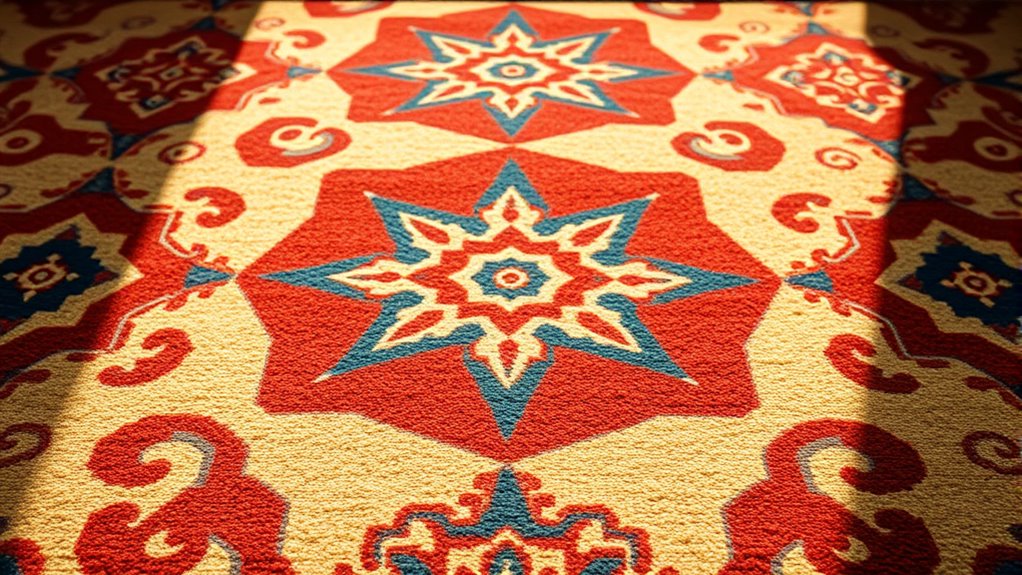
In Feng Shui, patterns are more than just decorative elements; they serve as powerful tools to influence energy flow and balance within a space. The textile textures of your rugs can enhance this effect, adding depth and tactile harmony. Pattern symmetry plays a vital role, as balanced designs promote a sense of stability and calm. When you select rug patterns with symmetrical motifs, you create a visual flow that encourages positive energy to circulate smoothly. Conversely, irregular or chaotic patterns may disrupt this flow, leading to disharmony. By consciously choosing rugs with harmonious textile textures and symmetrical patterns, you reinforce a peaceful environment. This thoughtful approach helps you align your space with the natural flow of energy, fostering well-being and serenity. Additionally, understanding the effectiveness of different pattern types can guide you in selecting designs that optimize the flow of positive chi.
Symbols and Their Impact on Energy Flow

Symbols on your rug carry specific meanings and intentions that can influence energy in your space. The patterns you choose affect the flow of Qi, either enhancing harmony or causing blockages. Recognizing the cultural significance of motifs helps you select designs that support your goals and promote positive energy. Incorporating cultural symbolism can further amplify the desired effects of your feng shui setup.
Symbolic Meanings and Intentions
Certain patterns in rug design carry powerful symbolic meanings that can influence the flow of energy in your space. Meditative motifs like lotus flowers or flowing water promote calmness and spiritual growth, while auspicious symbols such as dragons or phoenixes attract positive energy. These symbols serve as intentional reminders of your goals and aspirations, enhancing your environment’s harmony. Consider the following meanings:
| Pattern | Symbolic Meaning | Intentions |
|---|---|---|
| Lotus | Purity, enlightenment | Foster serenity and clarity |
| Dragon | Power, protection | Attract strength and safety |
| Water motifs | Flow, abundance | Invite prosperity and ease |
| Phoenix | Renewal, rebirth | Support transformation |
| Geometric shapes | Balance, stability | Promote order and harmony |
Additionally, incorporating energy flow principles into your rug choices can further enhance positive vibrations.
Pattern Influence on Qi Flow
Patterns in rugs directly influence the flow of qi by guiding energy throughout your space. When choosing a rug, consider how the pattern interacts with your room’s layout and the textile material used. Natural fibers like wool or jute promote smoother energy flow, while synthetic materials may hinder it. Sharp or chaotic patterns can disrupt qi, creating tension or stagnation, whereas calming, harmonious designs encourage positive energy movement. Regular rug cleaning removes dust and dirt that block energy pathways, ensuring that the pattern’s influence remains effective. Additionally, the textile material of the rug plays a significant role in how energy is transmitted and maintained. By selecting the right pattern and maintaining your rug’s cleanliness, you can optimize qi flow, fostering a balanced and vibrant environment. Your mindful choices in textile material and upkeep directly impact the energy harmony in your space.
Cultural Significance of Motifs
Motifs on rugs carry cultural meanings that can particularly influence the energy in your space. Traditional symbolism and cultural motifs often represent values, blessings, or protection. For example, a dragon symbolizes power and good fortune, while a peony signifies prosperity. These symbols impact energy flow by reinforcing positive intentions and harmony. Below is a table illustrating common motifs and their meanings:
| Motif | Cultural Significance | Impact on Energy Flow |
|---|---|---|
| Dragon | Power, protection | Enhances strength, vitality |
| Lotus | Purity, spiritual awakening | Promotes clarity, calmness |
| Phoenix | Renewal, rebirth | Invites transformation |
| Bamboo | Flexibility, resilience | Encourages adaptability |
Choosing rugs with meaningful cultural motifs can align your environment with your intentions, fostering balanced energy. Additionally, considering design elements can further enhance the overall harmony and flow within your space.
Geometric Designs and Their Effects on Balance
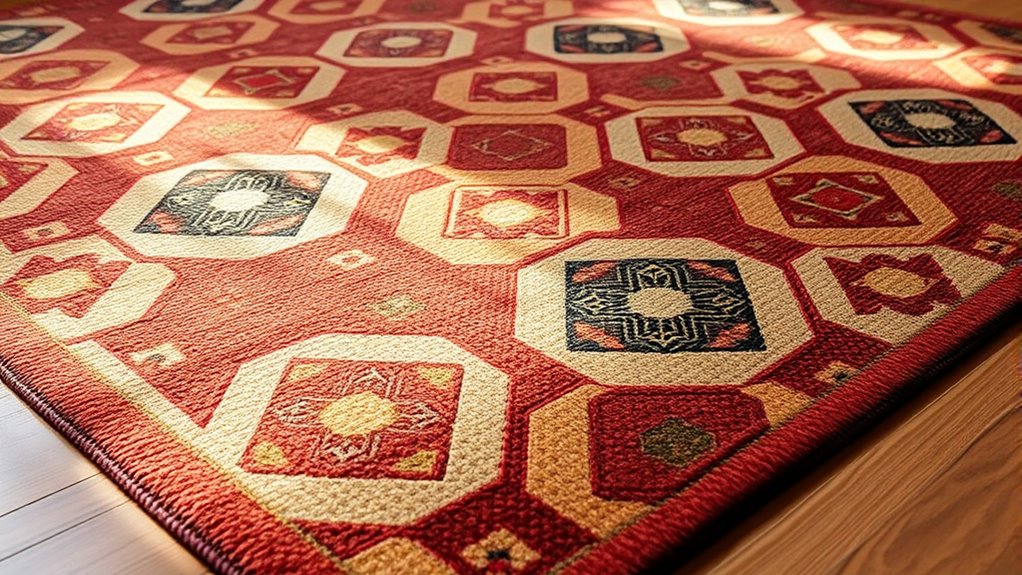
Geometric designs in feng shui are powerful tools for creating visual harmony and balancing energy in a space. They promote clarity and stability, especially with abstract motifs that evoke order and calm. Modern minimalism often features clean lines and simple shapes, which can help reduce clutter and enhance focus. To deepen this effect, consider:
Geometric feng shui designs foster harmony, clarity, and calm through balanced, abstract motifs.
- Using symmetrical patterns to promote equilibrium and flow
- Incorporating repetitive geometric shapes to reinforce stability
- Choosing rug designs with balanced proportions for a sense of harmony
- Selecting high-pressure application patterns that facilitate a sense of control and order within the environment
These elements work together to foster a balanced environment. Geometric patterns can subtly influence your perception, making spaces feel more organized and intentional. When thoughtfully selected, they support the flow of positive energy and contribute to overall serenity.
Floral and Nature-Inspired Patterns for Prosperity
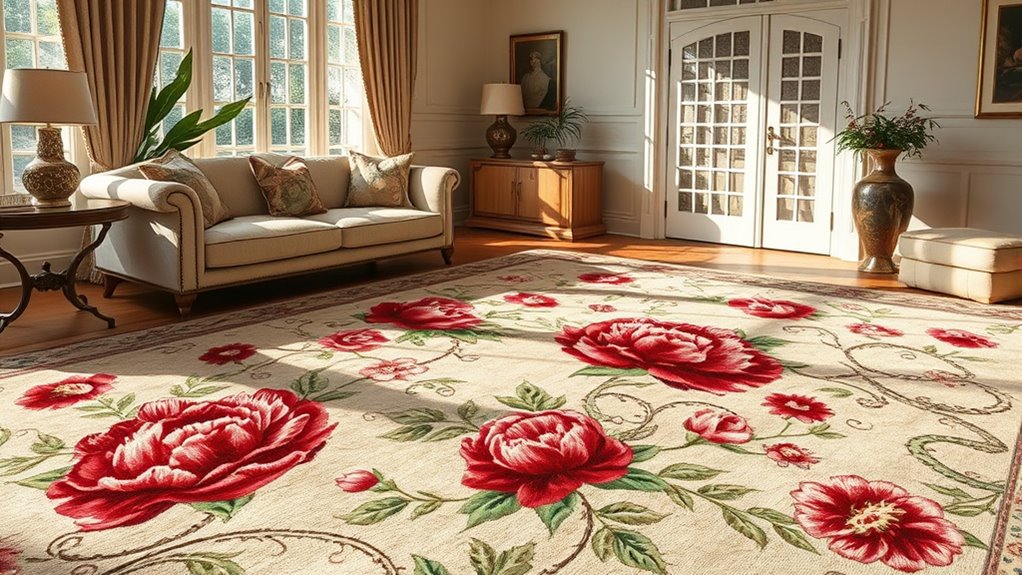
In feng shui, floral and nature-inspired designs are believed to attract abundance and positive energy. Incorporating botanical motifs into your rug can activate the flow of prosperity, especially when paired with strong floral symbolism. Flowers like peonies, lotus, and chrysanthemums symbolize wealth, growth, and harmony, making them ideal choices. These patterns encourage a vibrant, lively atmosphere that supports financial stability and personal development. When placing a rug with floral or natural motifs in your living space, focus on areas associated with wealth, such as the Southeast corner. The natural imagery helps to strengthen your intentions for prosperity, infusing your environment with energies that promote abundance and success. Embracing these patterns as a way to invite growth and positive opportunities into your life can also be enhanced by understanding the fundamentals of sound design, which emphasize creating harmonious environments through sensory elements.
Avoiding Chaos: Patterns to Steer Clear Of

Avoid patterns that create visual chaos, like clashing geometric designs or overly busy rugs. These can stimulate restlessness and disrupt the calming flow of your space. Stick to simpler, harmonious patterns to maintain balance and tranquility in your home. Incorporating balanced design principles can further enhance the peaceful atmosphere, aligning with the calming effects emphasized in Feng Shui.
Clashing Geometric Designs
Clashing geometric designs can create a sense of chaos and imbalance in your space, disrupting the flow of positive energy. Chaotic pattern clashes from clashing geometric designs make your environment feel unsettled and overwhelming. To avoid this, steer clear of patterns that compete visually, such as:
- Overly intricate shapes combined without harmony
- Bright, contrasting colors in busy geometric arrangements
- Repeating sharp angles that create jagged, aggressive visuals
These chaotic pattern clashes can overstimulate your senses, making it difficult to relax or focus. Instead, opt for harmonious, balanced patterns that promote calm and stability. Keeping geometric designs simple and cohesive helps maintain a peaceful flow of energy in your space. Additionally, choosing simple designs with muted color palettes can enhance tranquility and prevent visual clutter.
Overly Busy Patterns
Overly busy patterns can overwhelm your space, making it difficult to maintain a sense of calm and harmony. Pattern overload creates visual clutter that distracts the mind and disrupts chi flow. When a rug features complex, chaotic designs, it can add to the feeling of chaos rather than promote balance. Instead of fostering relaxation, these patterns draw your attention away from serenity and focus. To cultivate a peaceful environment, opt for simpler, more understated designs that allow energy to flow freely. Light, subtle patterns help reduce visual clutter and prevent the space from feeling cluttered or chaotic. Remember, in Feng Shui, less is often more—especially when it comes to patterns that influence the overall harmony of your home. Incorporating local tips and mindful design choices can further enhance the tranquil atmosphere you seek.
Placement Strategies for Rug Patterns
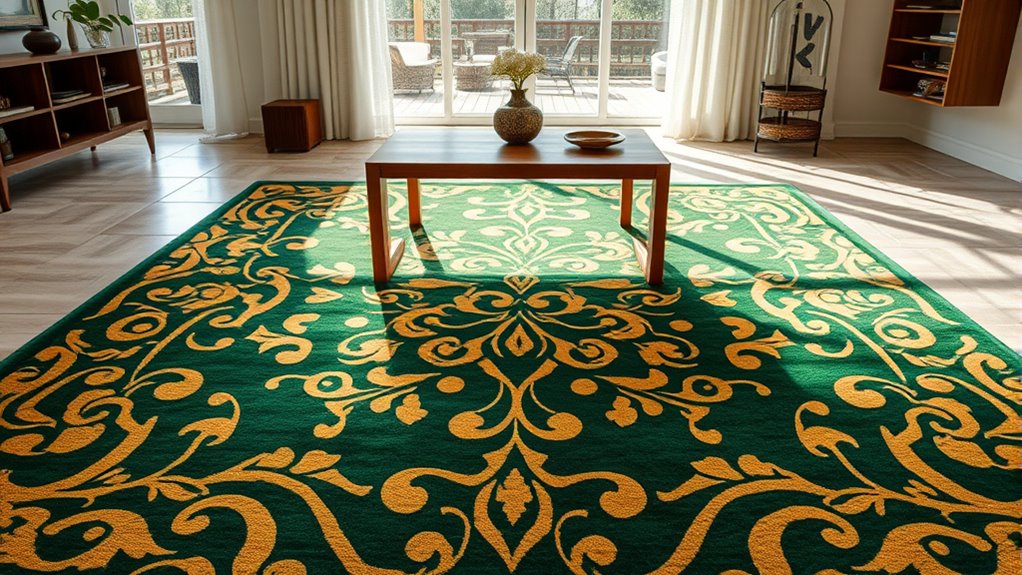
To effectively incorporate rug patterns into your space according to Feng Shui principles, you should carefully consider their placement. Strategic positioning enhances positive energy flow and supports desired effects. First, place rugs with smooth textures and calming patterns in the entrance or foyer to create welcoming energy. Second, select rugs with natural material textures, such as wool or jute, for living areas to promote stability and comfort. Third, position rugs with dynamic or intricate patterns in areas where activity and interaction occur, ensuring they are centered and not overwhelmed. Proper placement combines thoughtful material selection with pattern textures that align with your space’s function, helping you harness the full benefits of Feng Shui.
Color and Pattern Combinations for Harmonious Vibes
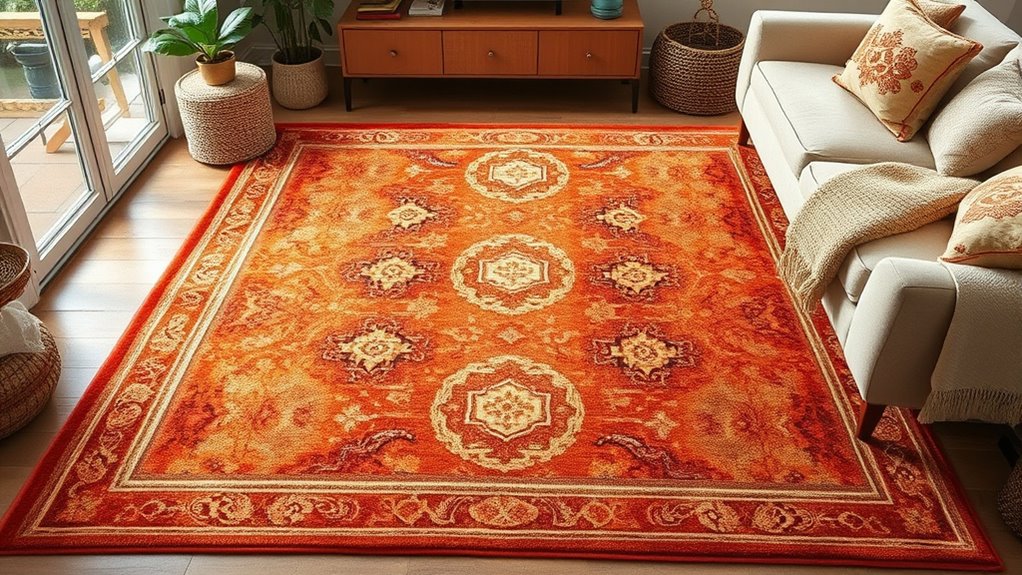
When selecting rug patterns and colors, pairing them thoughtfully can create a balanced and harmonious environment. Focus on texture contrast to add visual interest without disrupting harmony—smooth fibers against rough textures can energize a space subtly. Consider material symbolism; natural fibers like wool evoke warmth and stability, aligning with Earth elements, while silk suggests elegance and flow. Combining colors like soft greens with gentle patterns promotes calmness, fostering positive energy. Avoid overly busy designs that can create visual clutter, which may disturb the flow of qi. Instead, aim for a cohesive blend of color and pattern that complements your space’s natural elements. This thoughtful pairing enhances the room’s energy, supporting a peaceful, balanced atmosphere rooted in Feng Shui principles.
Choosing Patterns to Support Specific Areas of Your Home
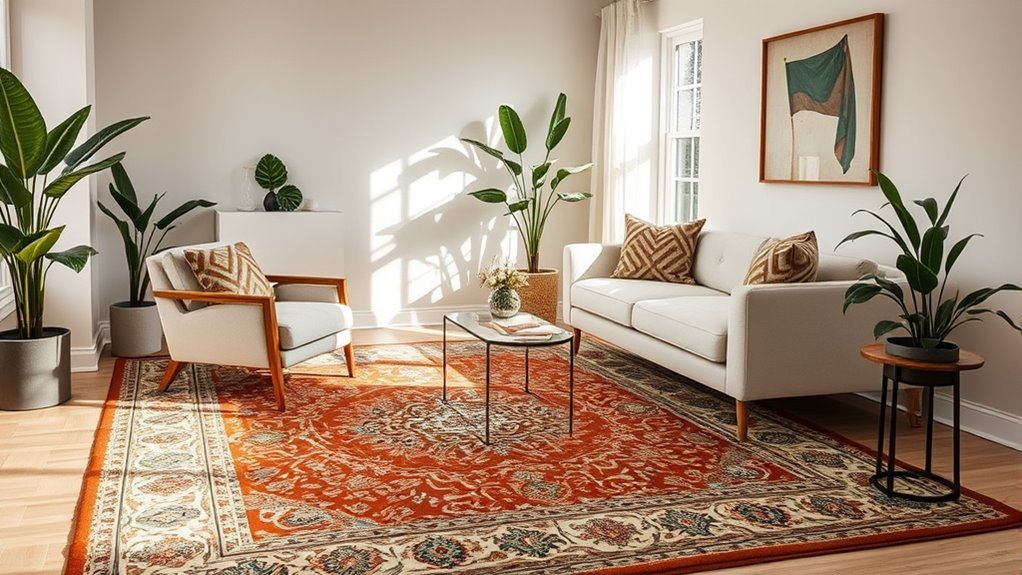
Choosing rug patterns that support specific areas of your home can markedly enhance the flow of energy and promote harmony. To do this effectively, consider texture variety and material selection, which influence how energy moves through a space. For example:
- Use soft, plush textures in the bedroom to create comfort and relaxation.
- Opt for natural materials like jute or sisal in entryways to promote grounding energy.
- Select bold, geometric patterns in the living room to energize and stimulate conversation.
Matching patterns with the room’s purpose helps reinforce positive chi. Incorporate a mix of textures to add depth and balance, ensuring energy flows smoothly. Thoughtful pattern choices support each space’s unique function and enhance overall harmony.
Tips for Incorporating Patterned Rugs Into Feng Shui Practice

Incorporating patterned rugs into your Feng Shui practice requires mindful placement and selection to enhance energy flow. Choose rugs in contemporary decor that complement your space’s overall vibe. To balance energy, place bold patterns in areas needing vibrancy, like living rooms, and softer designs in calming zones like bedrooms. Pattern customization options allow you to tailor rugs to your specific needs, promoting harmony. Use the table below to guide your choices:
| Area | Pattern Style | Tips |
|---|---|---|
| Living Room | Dynamic, energetic patterns | Stimulate activity; avoid cluttered designs |
| Bedroom | Soft, subtle patterns | Promote relaxation and rest |
| Entryway | Bold, welcoming patterns | Create positive first impressions |
| Workspace | Geometric, inspiring patterns | Boost focus and productivity |
Frequently Asked Questions
How Do Rug Patterns Influence Emotional Well-Being in Feng Shui?
Rug patterns can considerably influence your emotional well-being by how they evoke pattern symbolism and emotional resonance. You might notice that calming, harmonious patterns promote relaxation, while chaotic or aggressive designs can cause stress. By choosing patterns with positive symbolism, like flowing waves or gentle florals, you create a space that nurtures peace and balance. Your intentional selection of rug patterns directly impacts your mood and overall emotional health.
Can Specific Patterns Attract Positive or Negative Energy Intentionally?
You can influence energy intentionally through pattern symbolism and pattern placement on your rugs. Certain patterns, like circles or flowing designs, attract positive energy, while sharp or chaotic patterns may draw negative energy. By choosing patterns with meaningful symbolism and placing them thoughtfully in your space, you enhance harmony and balance, actively guiding the energy flow in your home.
Are There Cultural Considerations When Selecting Patterns for Feng Shui?
When choosing rug patterns for feng shui, you should consider cultural symbolism and traditional motifs, as these can influence the energy flow in your space. Different cultures associate specific patterns with luck, protection, or harmony. Being mindful of these cultural considerations helps you select designs that promote positive energy and respect cultural meanings. Ultimately, honoring traditional motifs guarantees your decor aligns with your intentions and enhances your environment’s balance.
How Do Patterns Affect the Perceived Size and Harmony of a Space?
Patterns influence your space’s visual perception and spatial dynamics. Bold or large patterns can make a room feel smaller or busier, while subtle or repetitive designs create a sense of harmony and openness. By choosing patterns carefully, you enhance balance and flow, making your space feel more inviting. Pay attention to how patterns interact with furniture and lighting to optimize harmony and perceived size in your environment.
Can Pattern Combinations Be Used to Enhance Specific Feng Shui Elements?
Think of pattern combinations as a symphony for your space, where each element plays a crucial role. You can use pattern symbolism and color coordination to amplify specific feng shui elements, like water or fire, by choosing patterns that represent those energies. Carefully blending harmonious patterns helps channel positive flow, turning your room into a vibrant sanctuary that nurtures balance and boosts your well-being.
Conclusion
By thoughtfully selecting rug patterns, you craft a tapestry of positive energy in your home, much like tuning a delicate instrument. When patterns flow harmoniously with your space, they guide energy smoothly, creating a balanced and inviting environment. Trust your intuition and consider how each design interacts with your surroundings. With mindful choices, your rugs become more than decor—they become the heartbeat that fuels your home’s vibrant, harmonious rhythm.
